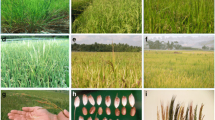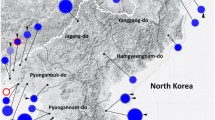Abstract
In Bhutan, weedy rice (Oryza sativa L.) was grown together with cultivated rice on terraced paddy fields lower than 2620 m above sea level. Seeds of cultivars and weedy strains were collected at 22 collection sites located from 1000 to 2620 m above sea level. Cultivars with round seeds were frequently found in fields higher than 2250 m, and those with slender seeds in fields lower than 1630 m. All cultivars and weedy strains were divided into indica or japonica types by isozyme (multi-locus) and morpho-physiological (multicharacter) analyses. Japonica cultivars predominated in highland; Indica cultivars predominated in lowland. Plastid type was confirmed by the length polymorphism for the ORF100 region. The japonica cultivars carried non-deletion type ORF100. The indica cultivars carried deletion type ORF100. In contrast, weedy strains showed discrepancy in the combination of the nuclear and cytoplasm types. An intermediate type was found in weedy strains for isozyme genotypes. A recombinant type, which has indica genotypes for isozyme analysis with japonica cytoplasm, and vice versa, was frequently found in weedy strains. These findings suggested that weedy strains would be generated by natural hybridization between indica and japonica. Further, they might fail to recombine their prior genotypes sets for isozyme and cytoplasm. Morphophysiological characters did not show such a tendency. Morpho-physiological analysis of highland plants, in particular, showed indica cultivars and weedy strains with japonica cytoplasm. Hypervariable nuclear microsatellite analysis was then used to compare cultivars and weedy strains. Identical alleles were shared between indica and japonica, and also between cultivars and weedy strains. This suggested that there was gene-flow resulting from natural hybridization.
Similar content being viewed by others
References
K. Arashi (1974) Some Thoughts on Red Rice in Japan Nihon akamai Ko Yuzankaku, Tokyo 295
H.G. Baker (1974) ArticleTitleThe evolution of weeds Annu. Rev. Ecol. Syst. 5 1–24 Occurrence Handle10.1146/annurev.es.05.110174.000245
W. Cai H. Morishima (2002) ArticleTitleQTL clusters reflect character associations in wild and cultivated rice Theor. Appl. Genet. 104 1217–1228 Occurrence Handle10.1007/s00122-001-0819-7 Occurrence Handle12582574
M. Catala-Former (1995) ArticleTitleChemical and cultural practices forred rice control in rice fields in Ebro Delta (Spain) Crop. Prod. 14 405–408
W.B. Chen I. Nakamura Y.I. Sato H. Nakai (1993) ArticleTitleDistribution of deletion type in cpDNA of cultivated and wild rice Jpn. J. Genet. 68 597–603 Occurrence Handle10.1266/jjg.68.597
A. Diarra R.J. Smith R.E. Talbert (1994) ArticleTitleGrowth and morphological characteristics of red rice (Oryza sativa) biotypes Weed Sci. 33 310–314
Harlan. (1965) ArticleTitleThe possible role of weed races in the evolution of cultivated plants Euphytica 14 173–176 Occurrence Handle10.1007/BF00038984
M.H. Heu (1988) ArticleTitleWeed rice “Sharei" showing closer crossaffinity to Japonica type Rice Genet. Newslett. 5 72–74
R. Ishikawa Y.-I. Sato L. Tang I. Nakamura (2002) ArticleTitleDifferent maternal origins of Japanese lowland and upland rice populations Theor. Appl. Genet. 104 976–980 Occurrence Handle10.1007/s00122-001-0807-y Occurrence Handle12582602
R. Ishikawa I. Nakamura T. Nishihara KikuchiM. M. Senda S. Akada T. Harada M. Niizeki (2002) ArticleTitleOrigin of cytoplasm substituted rice cultivars found in Japan Theor. Appl. Genet. 105 608–613 Occurrence Handle10.1007/s00122-002-0898-0 Occurrence Handle12582511
A. Kanno N. Watanabe I. Nakamura A. Hirai (1993) ArticleTitleVariations in chloroplast DNA from rice (Oryza sativa): Differences between deletions mediated by short direct-repeat sequences within a single species Theor. Appl. Genet. 86 579–584 Occurrence Handle10.1007/BF00838712
S. Kato H. Kosaka S. Hara (1928) ArticleTitleOn the affinity of rice varieties as shown by the fertility of rice plants Centr. Agric. Inst. Kyushu Imp. Univ. 2 241–276
H. Morishima L.U. Gadrinab (1987) Are the Asian common wild rice differentiated into indicana japonica types? S.C. Hsieh (Eds) Crop Exploration and Utilization of Genetic Resources. Taichung District Agricultural Improvement Station Changhua (Taiwan) 11–20
H.I. Oka (1953) ArticleTitleVariations in various characters and character combination among rice varieties Jpn. J. Breed. 3 33–43
H. Oka (1988) Weedy form of rice. Origin of Cultivated Rice Elsevier Japan Sci Press Amsterdam, Tokyo 107–114
R. Sano H. Morishima (1992) ArticleTitleIndica-iaponica differentiation of rice cultivars viewed from the Himalayan hilly areas Theor. Appl. Genet. 84 266–274 Occurrence Handle10.1007/BF00229481
Y.I. Sato S. Chitorakon H. Morishima (1986) The indicajaponica differentiation of rice cultivars in Thailand and its neighboring countries B. Napompethh S. Subhadrabandhu (Eds) New Frontiers in Breeding Researches, Proceedings of the 5th International Congress SABRAO. Kasetsart University Bangkok 185–193
Y.I. Sato (1991) ArticleTitleVariation in spikelet shape of the indica and japonica rice cultivars in Asian origin Jpn. J. Breed. 41 121–134
H.S. Suh W.G. Ha (1994) ArticleTitleCharacters variation of Korean weedy rice Rice Genet. Newslett. 11 69–79
H.S. Suh Y.I. Sato H. Morishima (1997) ArticleTitleGenetic characterization of weedy rice (Oryza sativa L.) based on morphophysiology, isozymes and RAPD markers Theor. Appl. Genet. 94 316–321 Occurrence Handle10.1007/s001220050417
L. Tang H. Morishima (1988) ArticleTitleCharacteristics of weed rice strains Rice Genet. Newslett. 5 70–72
J.M.J. Wet Particlede J.R. Harlan (1975) ArticleTitleWeeds and domesticates; evolution in man-made habitats Econ. Bot. 29 99–107
Author information
Authors and Affiliations
Corresponding author
Rights and permissions
About this article
Cite this article
Ishikawa, R., Toki, N., Imai, K. et al. Origin of Weedy Rice Grown in Bhutan and the Force of Genetic Diversity. Genet Resour Crop Evol 52, 395–403 (2005). https://doi.org/10.1007/s10722-005-2257-x
Received:
Accepted:
Issue Date:
DOI: https://doi.org/10.1007/s10722-005-2257-x




